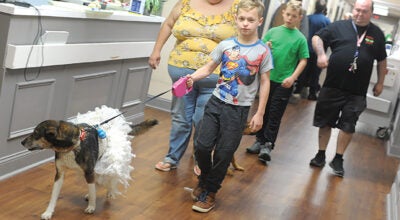Abusive life can be escaped
Published 12:02 am Sunday, October 7, 2012
October is National Domestic Violence Awareness Month, a time set aside to focus the spotlight on what domestic abuse is and the resources available to help those who suffer at the hands of people who claim to love them.
Jane Smith is a Tri-State woman whose name has been changed to protect her identity.
To Jane Smith, every month is domestic violence awareness month. She was a victim of a man who often left her covered in bruises and once tried to kill her. But she got away from her abuser and Smith now calls herself a survivor.
How it started
Jane met John Smith shortly after he got out of the military.
Like many abusers, Smith said her ex-husband could be very charming in public and was charming to her at first.
“My family loved him. It was hard to tell them what was going on,” Smith said. “He was handsome, personality-plus.”
Domestic violence advocates will tell you abusers rarely start a relationship by beating their victims. First there are the put downs, the insults, the comments.
There was the verbal abuse to make her feel unworthy. He would often make derisive comments about her “college educated mind.” Smith will tell you the verbal and emotional abuse is often more crushing to the victim than the physical violence.
When the violence began, Smith at first thought it was a painful but normal part of the male-female relationship. After all, she grew up seeing men abuse women and children. Over time, though, she came to hate what was happening to her. She came to hate the controlling, angry person whose fists ruled their home and their marriage.
“There was once I was so disfigured you couldn’t recognize me other than my eyes,” Smith said.
When she called the police on him for abuse, the police would take him away, but he would come back, angrier than ever and the abuse would be worse.
The Smiths and their abusive relationship became well-known to the judge who heard and dealt with John Smith’s many trips to court.
Smith said she would frequently leave and hide from him but somehow John always found her, even when she moved.
“I left him five times,” Smith said. “I had D.P.O.s and C.P.O.s and I would drop them.”
In 1995 he started abusing her in front of the children, something that has affected their two daughters to this day, she said, even though the girls are now grown.
“At one point social services got involved and one social worker told Smith she had to choose her children or her abuser. Her daughters were taken away from her three times before she finally made her permanent break from John.
Help from those who care
“I’ve been in five spouse abuse centers — I didn’t even know they existed — since 1995,” Smith said.
Over time, the help she received at these domestic violence centers began to strengthen Smith’s understanding of what domestic abuse is, and that for the sake of her and her children, she had to get away from it.
At one center, a counselor asked her to write down what had been the most serious abuse she had encountered. Smith had trouble deciding which incident was worse than the others.
“Thank God for her (the counselor). She made me realize what I was going through,” Smith said.
She started divorce proceedings in 1999 but it took two years to finalize it because her husband frequently stalled the process.
Smith laments that laws to protect victims are weak and often ineffective.
“I’ve seen me and others brutally hurt and it’s just an assault charge,” Smith said.
A life worth living
Smith completed her bachelor’s degree after her divorce, which she considers tangible proof that she is stronger than she once thought she was.
She has a job and a life away from the man who professed his love for her and yet tormented her. She is firm in her belief that domestic violence counselors and advocates can help victims become survivors. She is, after all, living proof.
“Those agencies and programs are there to help you,” Smith said.




